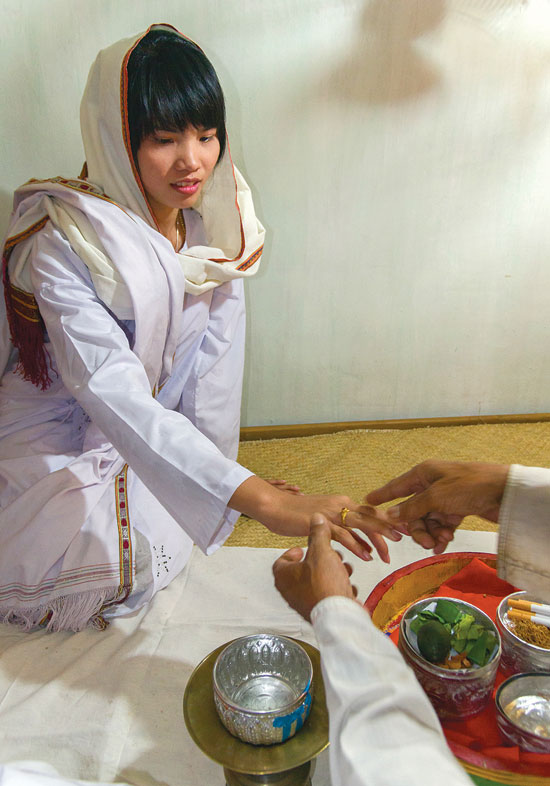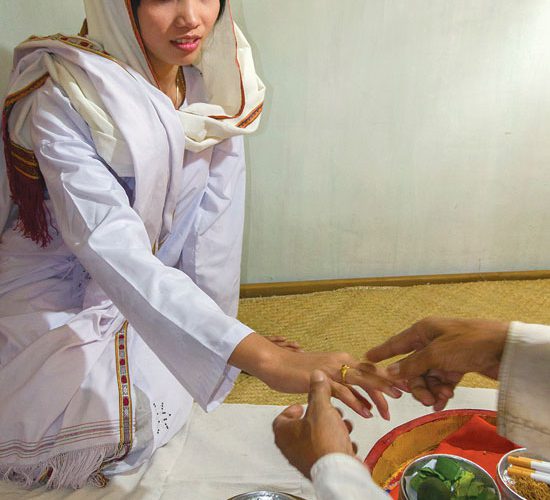(No.4, Vol.6,June-July 2016 Vietnam Heritage Magazine)




When they converted to Islam, the Cham people made major changes to the faith, which they call Cham Ba-ni or Cham Awal. The main reason is that the Cham society remains matriarchal, and so Islam had to be restructured to fit into their way of life.
In their traditions, Cham Ba-ni adolescents have to pass a ‘maturity ritual’ – karoh for girls and katat for boys, before they can get married. Women betroth men. After the wedding, the man moves to his wife’s house and lives there for the rest of his life.
Cham Ba-ni weddings, called Dam Likhah, are organized only in third, sixth, tenth and eleventh months of the Cham calendar, which are considered the most suitable. The even days near the end of month, representing the Mother, are the best. Nowadays, the rules are somewhat loosened, but still there are three taboo days: full moon, the 16th and ‘out of moon’ days.
The process of getting married consists of a few steps in the following order. First, match makers from the bride’s side come to the groom’s family to ask for his hand. They would normally say ‘A good buffalo is needed for a good crop.’
Not long after that, the bride’s party comes to the groom’s side again in a simple betrothal ceremony with offerings such as betel and areca, wine and a few kinds of cakes. Dried sting ray is a must, because it represents fertility.
The next step is paklauh panwoc, literally, ‘final word’ ceremony, in which representatives of the two sides decide the wedding dates and invited guests. After this, changes are normally not allowed. Finally, the official wedding takes place.

A Cham life has three births, of which the wedding is the second, and it’s not the person’s parents who give it, but the adoptive parents. The adoptive parents must have a continuous family life, be the same age as the real parents, and possess enough know-how about the rituals to be performed in the ceremonies. The inu amu conducts the whole wedding process, and only then the parents of both sides can communicate.
The wedding ceremony consists of three steps: Muslims generally have to conduct their weddings at a mosque. But the Cham Ba-ni changed the rules drastically. If the wedding takes place on a Wednesday, then, the previous evening, the groom is sent to a relative’s so he is no longer a member of his family. On the following day at noon the groom’s family has a simple celebration with modest offerings.
After that, the bride’s family sends their inu amu to escort the groom’s family to receive them to their house for the wedding. At about 2-3 o’clock, the procession leaves the groom’s place. The bride’s family conducts the receiving the inlaws ritual at the village gate if the groom comes from another village, or at an end of their street if he comes from the same village. The ritual lasts about 10 minutes, and then the whole group goes inside.


After the happy opening ceremony, the monks instruct the newlyweds not to have any physical contact in the first three nuptial days and nights. To help the young couple avoid intimate gestures, some relatives put a happy marriage tray with betel, areca and burning candles in the middle of the bed. The candles are burnt for three days while the young couple is under vigilant warch.
The photo series of Cham Bani’s wedding was taken in 2014-2015 at Phan Ri Thanh, Bac Binh District, Binh Thuan Province.
It won the first prize of the photo contest ‘Binh Thuan – Green Convergence 2015’.
Photos: Ngo Quang Phuc
At a good hour, the groom is led into the bride’s room in a ritual quarter to be introduced to the house’s god. Then the two come out to the feasting crowd to greet them and to receive their congratulations.
On the next day, if the newlyweds are first time married, or Tuesday. Otherwise, the official wedding begins. At about 8 o’clock in the morning, as the newlyweds step out of the nuptial chamber, they stumble on the imam. This Ba-ni cleric would pretend to have found a couple living together illegally. So he would punish them up to a hundred lashes and make them kowtow. The punishment is also pretend. Then, the forgiveness-begging ritual follows. Kneeling in front of the cleric are the groom, the bride, the bride’s mother and their relatives, in that order. The clergyman reads prayers, praying Allah to bless the wedded couple.
After a feast to treat the groom’s family, the inu amu performs the paywa anuk mutuw ritual, after which everybody returns to the bride’s house. Here the groom’s inu amu holds the groom’s hand in his right hand and gives it to the bride’s inu amu, who takes it in his left hand and leads the groom into the nuptial chamber. After consecrating, exorcising and arranging the bed, the two inu amu tell the bride and groom not to have sex for three days and nights. A tray of betel and areca is put in the middle of the bed, and candles are lit days and nights. Only after the tray is removed can the newlyweds have sexual intercourse for the first time. However, this custom is no longer maintained in the Cham Ba-ni communities of Phan Rang.
After the three days of wedding, the bride’s family brings food offerings to the groom’s family for a farewell ceremony, which is called taloh khan aw by Hindu Cham. The bride’s family asks for the groom’s personal belongings. Only now the couple officially becomes husband and wife.
During married life, if for any reason the husband leaves the wife’s family to return to his parents’, the wife’s family would come to his parents and ask their permission to have him back. If the problem is too serious, the two big clans have to perform a ‘chopstick splitting’ procedure. Upon divorce, no Cham husband can take home any mutual asset.
* The author is a poet and Cham cultural researcher
The Cham, also called Chiem Thanh, or Hoi, live mainly in Cambodia, Vietnam, Malaysia and Thailand. There are currently about 145,000 Cham people living in Vietnam, mostly in the middle part of the country. The highest Cham population is located in Binh Thuan and Ninh Thuan provinces.
Before the 7th century, The Cham had an independent kingdom, called Lam Ap or Champa in the territory which is now the southern part of Middle Vietnam. The kingdom shrank as Vietnam was expanding. In 1832, Champa was totally annexed by Vietnam.

